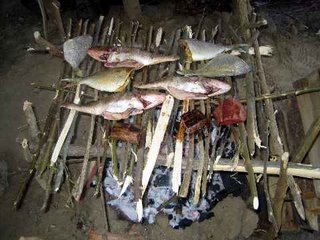 Jefferson Patterson Park and Museum (JPPM) hosted American Indian Heritage Day on Saturday, August 12 and Earth Connection was there. The weather could not have been any better than it was, not too hot with a slight breeze off the bay.
Jefferson Patterson Park and Museum (JPPM) hosted American Indian Heritage Day on Saturday, August 12 and Earth Connection was there. The weather could not have been any better than it was, not too hot with a slight breeze off the bay. The event featured educational sessions and entertainment highlighting American Indian culture and history through hands-on activities, demonstrations, exhibits, and live performances. Days before the event Governor Ehrlich Jr. encouraged "… all Marylanders to attend American Indian Heritage Day and learn more about the history and culture of our great state's original inhabitants," which I suspect a few took his encouragement to heart.
Although it was a slow start out at the Indian village, many made it down to our humble village of demonstrations. There were over 1500 visitors over all. Those 1500 or so guests experienced traditional and contemporary expressions of American Indian cultural heritage, including music, storytelling, arts, and crafts. Many of the visitors explored the hands-on activities in pottery, finger weaving, archery, hide tanning, primitive cooking and stone tool making. The event also featured the continuing construction of replica woodland Indian village with a wigwam and work shelter where the primitive cooking was set up.
The Mid-Atlantic Primitive Skills Group (MAPS) provided demonstrations on primitive cooking, cordage and hide tanning for the event in the woodland Indian village still under construction. Oregon Ridge Nature Center provided stone tool making. Earth Connection (EC) provided some of the primitive cooking demonstrations with MAPS.
EC provided a green stick grill, pit cooking and clay pot oven demonstrations. We cooked up croaker and spot fish, buffalo, venison, game hen, quail, corn on the cob, plenty of vegetables, but only the demonstrators could partake of the bounty. Guests were bound to the food provided by the event concessionaires. That was good for us.

There were also many folks that stopped by to say hello during the event that have come to EC classes in the past. I hope to see more of them out at EC in the future.
